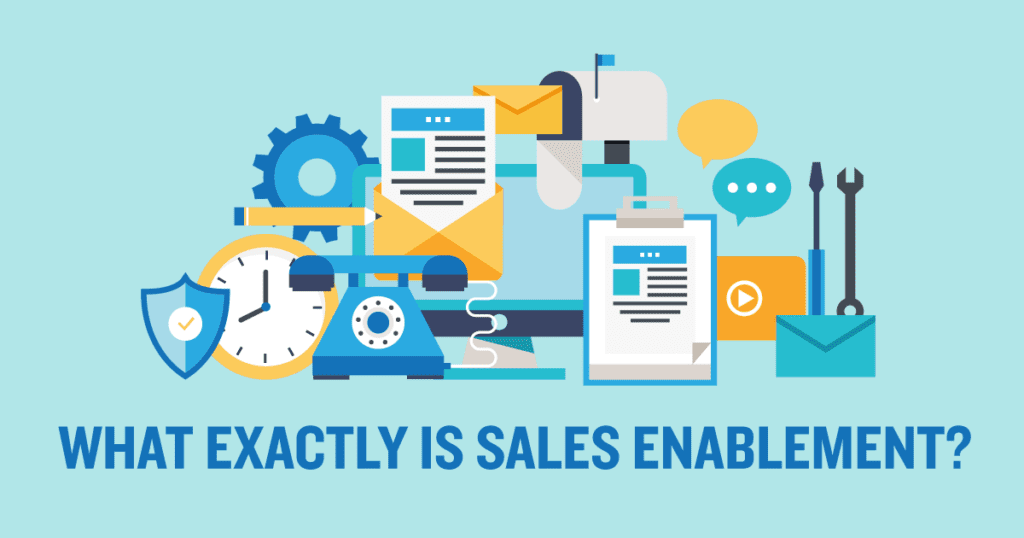Sales enablement is a process that allows an organization to equip its salesforce with information, content and tools that help it sell with more efficiency, while replacing simple tasks with powerful automation. The main function of sales enablement is empowerment: sales enablement empowers your entire sales team to keep customers engaged throughout every stage of the customer acquisition funnel.
Sales enablement is a relatively newer concept and the true meaning of the term ‘Enablement’ is still unfolding as the technologies and processes advance. However, enablement’s business definition is – It is the process of enabling and empowering business users and putting them in a position to take decisions or make changes for efficient business practice – without IT being an obstruction.
Earlier, sales enablement was defined as sales asset management and content management. This definition simply outlines its role of organizing and managing sales material so that it is readily available to the salesforce.
Though content management still remains a crucial part of the enablement process, today, the scope of sales enablement transcends that. Now, sales enablement solutions have become more about enabling the entire business to ensure more sales. For eg. The front desk and customer support staff have accurate knowledge of your products or services, salesforce has easy access to product and customer information, sales managers can track performance to identify and bridge gaps, departments and teams can work in synergy to avoid any discrepancy. Sales enablement tools are powered by artificial intelligence, machine learning, automation, and other advanced technologies to enhance the overall performance of an organization.
What are the benefits of sales enablement?
For any organization to grow and succeed, there has to be synergy between teams and departments. Companies that align the activities of their sales and marketing department always have a higher chance of closing more sales. However, organizations have always found bridging that gap a difficult task till now. Sales enablement allows the seamless alignment of marketing and sales departments. The right sales enablement platform lets you align marketing and sales such that wider communication channels are resulting in frequent collaborations.
Here are some benefits of sales enablement
Improved communication and collaboration
Ensuring seamless communication between sales and marketing is a challenge for many businesses. Sales enablement platforms help organizations to overcome this challenge by providing better systems to store and organize sales material. A content management system is a system that manages data in a way that is accessible to all at the right time. This allows collaboration between teams and departments, especially sales and marketing.
When sales enablement tools, marketing, and sales CRM, and other business processes are aligned, organizations can enhance their activities using these combined data and insight. Sales and marketing teams can collaborate to better define buyer personas and hence, increase the efficiency of the sales process.
Optimized content
Collaboration can lead to content optimization with the help of the marketing team’s knowledge of leads and the sales team’s knowledge of buyers. This optimized content can then help in moving the prospect through the sales funnel faster.
The two departments, while collaborating, can also work towards creating customization content that the sales reps can personalize based on the needs of any prospect.
Increased revenue
Enhanced overall performance is the most important benefit of sales enablement. With optimized content, combined insights, marketing-sales transparency, and improved communication, sales reps become more equipped to close deals better and generate more revenue.
How does sales enablement work?
Sales enablement not only aligns teams or optimizes content, but it also enhances the entire sales process by ensuring transparency, better insights, and improved training tools and processes.
Enhanced on boarding: Effective and faster hiring will directly result in faster sales quota attainment. Best sales enablement platforms help the sales enablement manager to identify the strengths and weaknesses of the reps and adjust the activities for sales training accordingly.
Growth and skill development: Benefits of sales training can only be reaped when it’s ongoing. Sales enablement tools can help in Salesforce enablement through structured and interactive training. It provides virtual role-play, simulated sales, and feedback for growth and improvement.
Insight and analytics: allows you to track your sales reps’ understanding of their training. It enables the trainer to identify the knowledge or skill gap and develop programs to bridge those gaps and hence improve the capabilities of the sales force.
Sales enablement may have changed from what it was initially defined as, but the end goal of it is still the same: enabling the Salesforce to add value to the sales process and execute their role with increased efficiency.
Connect with a member of our Solutions team today to build your sales team into a world-class, customer-converting workforce.

